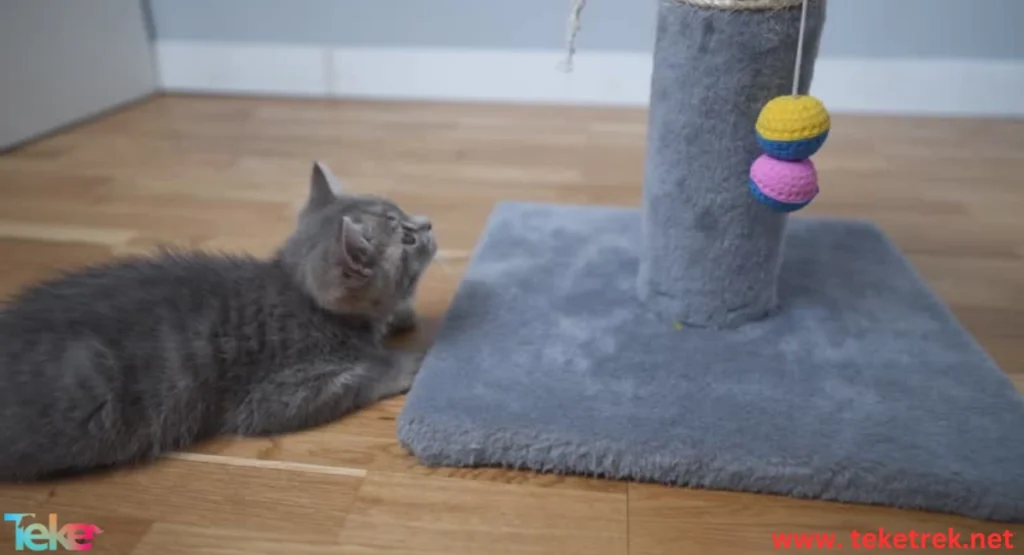Cats are beloved pets, and many people enjoy raising them. It is well known that cats have sharp claws that help them defend themselves, climb to high places, and assist in eating and cutting food. However, many cat owners face a major issue with their cats’ claws as they tend to scratch furniture, tear clothes, and damage toys, among other problems. Therefore, cat owners often seek solutions to this issue. There are several effective ways to prevent cats from scratching, such as providing designated scratching areas or offering specific tools and toys for scratching instead of household furniture. Below is a comprehensive guide from teketrek، on how to prevent cats from scratching.
The Importance of Providing Alternative Scratching Areas
Cats naturally scratch anything they find in front of them, which is a natural behavior. However, this behavior can cause damage to household furniture. A great solution is to designate an alternative area for the cat away from living spaces containing furniture, carpets, and other scratchable materials. This can be done by setting up a room outside the house with basic necessities and toys that the cat enjoys playing with and scratching. Alternatively, an indoor room with designated scratching posts can be set up to allow the cat to exhibit its scratching behavior on appropriate surfaces.

Best Scratching Tools for Cats: Wood, Cardboard, and Sisal-Covered Posts
Purchasing scratching tools that cats prefer is an effective way to prevent them from damaging household furniture. Cats enjoy scratching wood, cardboard, and sisal-covered posts. Therefore, buying scratching posts covered in a material that your cat likes is beneficial. Some cats prefer fabric, while others prefer wood. Observing your cat’s preference and buying accordingly can help. Additionally, choosing large and wide scratching surfaces ensures the cat enjoys them and does not turn to furniture when bored. Providing tools with ropes or sisal also helps keep the cat engaged and away from other objects.
How to Make Your Cat Prefer Scratching Its Post Instead of Furniture
To encourage your cat to scratch its post instead of furniture, you first need to understand its preferences. Observe whether your cat enjoys scratching wood, sisal, or fabric. Once identified, place the preferred material on the scratching post to attract the cat. Several factors should be considered for the scratching post: it should be tall, sturdy, and stable to mimic trees that cats naturally enjoy scratching. The post should also be long enough to allow the cat to stretch and strengthen its back and shoulder muscles, promoting healthy growth.
Using Nail Caps for Cats: Are They Effective?
Nail caps for cats are a safe and effective solution that prevents them from damaging furniture. These caps are plastic covers that are glued onto the cat’s claws and last for about seven weeks. They do not cause any pain or interfere with natural claw growth. While they are useful in preventing furniture damage, one drawback is that they hinder a cat’s ability to defend itself if attacked by another animal. However, this issue can be avoided by ensuring the cat does not interact with unfamiliar animals. Nail caps effectively prevent furniture scratching and destruction.
Can Cats Be Trained to Stop Scratching?
Harsh punishment, such as hitting, will not stop a cat from scratching; instead, it will make the situation worse because scratching is a natural instinct. Instead, cats can be gradually trained to stop scratching unwanted areas by encouraging them to use designated scratching posts. When the cat exhibits undesirable scratching behavior, the owner can spray it with water—cats dislike this, and with repeated instances, they will associate scratching furniture with an unpleasant consequence and stop the behavior.
Effective Methods to Reduce Cat Scratching on Furniture
There are various methods to deter cats from scratching furniture, including:
- Covering furniture with adhesive tape to make it less appealing to cats.
- Using aluminum foil, which cats dislike and avoid.
- Placing scratching posts near furniture as an alternative.
- Using strong-smelling substances and citrus scents to deter cats from scratching furniture.
Fragrances and Substances That Repel Cats from Scratching
Several substances can be used to discourage cats from scratching, including:
- Orange oil, which cats dislike.
- Lemon oil, which is also unappealing to cats.
- Spraying furniture with strong fragrances or perfumes to deter cats.
- Using vinegar as a natural repellent to keep cats away from furniture.
Does Trimming a Cat’s Claws Help Reduce Scratching?
Yes, trimming a cat’s claws can help minimize scratching damage. However, it is essential to learn the proper and safe way to trim a cat’s claws to avoid injuring them. Improper trimming can harm the cat and lead to behavioral changes.

When Is Scratching a Sign of a Health or Psychological Problem?
Excessive scratching can indicate health or psychological issues in cats. If a cat aggressively scratches furniture and displays violent behavior, it might be seeking attention from its owner or feeling neglected, especially if a new pet has been introduced or if the cat has moved to an unfamiliar home. Persistent and excessive scratching can lead to stress-related illnesses and weaken the cat’s immune system.
Frequently Asked Questions
What is the best spray to prevent cats from scratching?
BioLine spray is one of the best options for preventing cats from scratching. It contains safe and effective ingredients that do not harm cats, furniture, or fabrics.
Conclusion
Scratching is a natural and common behavior in cats, allowing them to mark their territory by leaving their scent on objects like trees and posts. However, this behavior can be frustrating for cat owners as it can cause furniture damage. Several effective solutions can help prevent scratching, such as providing designated scratching areas, using nail caps, purchasing appropriate scratching tools, and using strong-smelling repellents on furniture. These methods are effective and can help reduce unwanted scratching behavior.





